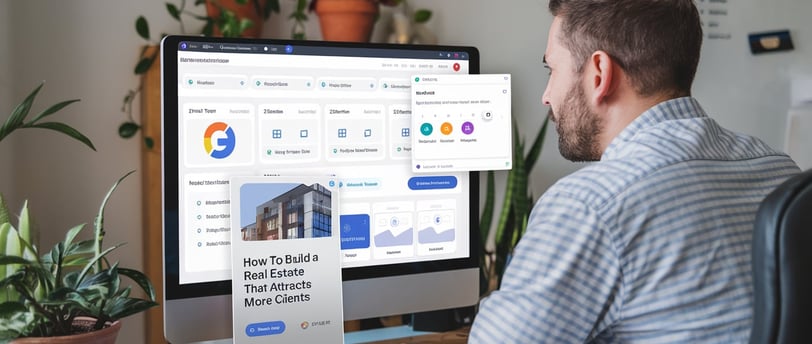How to Build a Real Estate Website That Attracts More Clients
1/18/20253 min read


In today’s digital-first world, your real estate website is more than just a virtual storefront—it’s a powerful tool for attracting and converting potential clients. A well-designed, SEO-optimized website can establish your authority, generate high-quality leads, and drive business growth. Here’s how to build a real estate website that stands out and delivers results, with tips on integrating software tools to manage leads effectively.
1. Create a User-Friendly Design
A website that’s visually appealing and easy to navigate keeps visitors engaged and increases the likelihood of conversion.
Actionable Strategies:
Mobile-Responsive Design: Ensure your website looks great and functions seamlessly on smartphones and tablets.
Clear Navigation: Use intuitive menus and categories to help users find listings, resources, and contact information quickly.
Fast Loading Times: Optimize images and code to minimize load times, as slow sites deter users.
Software Integration:
Use SaaS tools that provide pre-designed templates and drag-and-drop features to simplify the website-building process.
2. Optimize for SEO
Search engine optimization (SEO) helps your website rank higher on Google, increasing visibility to potential clients.
Actionable Strategies:
Local Keywords: Include phrases like “homes for sale in [city]” or “real estate agents near [area]."
On-Page SEO: Optimize meta titles, descriptions, and headers with target keywords.
Create Valuable Content: Publish blogs, market reports, and guides tailored to your audience’s interests.
Image Optimization: Use descriptive file names and alt text for all property photos.
Software Integration:
SEO Tools: Leverage SaaS platforms that include built-in SEO checkers and analytics to monitor keyword performance.
3. Showcase Property Listings Effectively
Your website should highlight your listings in a way that captures attention and provides all the necessary details potential buyers need.
Actionable Strategies:
High-Quality Images and Videos: Invest in professional photography and virtual tours for a polished look.
Advanced Search Filters: Allow users to filter listings by price, location, property type, and more.
Interactive Maps: Include maps that show property locations and nearby amenities.
Software Integration:
Use a SaaS tool with an MLS (Multiple Listing Service) integration to automatically update listings on your site.
4. Implement Lead Capture Tools
Capturing visitor information is essential for turning website traffic into actionable leads.
Actionable Strategies:
Contact Forms: Place easy-to-fill forms on key pages, such as property listings and your “Contact Us” page.
Live Chat: Add a chatbot or live chat feature to answer visitor questions in real time.
Calls-to-Action (CTAs): Use compelling CTAs like “Schedule a Viewing” or “Get a Free Home Valuation.”
Software Integration:
Lead Management Tools: Integrate CRM software to automatically store and track lead data.
Automated Follow-Ups: Set up SaaS tools that send instant email or SMS confirmations after form submissions.
5. Leverage Content Marketing
Educational and engaging content positions you as a trusted expert and keeps visitors returning to your site.
Actionable Strategies:
Blog Posts: Write about topics like homebuying tips, local market trends, and staging advice.
Video Content: Create short videos showcasing your listings or offering real estate advice.
Neighborhood Guides: Highlight local amenities, schools, and attractions to appeal to relocating buyers.
Software Integration:
Use SaaS platforms with blogging and video hosting features to streamline content creation and publishing.
6. Focus on Analytics and Performance
Tracking your website’s performance ensures you’re making data-driven improvements that lead to better results.
Actionable Strategies:
Monitor Traffic: Use tools to track how visitors find and interact with your site.
Analyze Behavior: Identify pages with high bounce rates and optimize them for better engagement.
Test and Refine: Use A/B testing for headlines, CTAs, and layouts to see what resonates with your audience.
Software Integration:
Analytics Dashboards: SaaS tools often come with built-in dashboards for tracking key metrics like traffic, conversions, and lead sources.
7. Build Trust with Testimonials and Social Proof
Showcasing positive reviews and success stories can instill confidence in potential clients.
Actionable Strategies:
Client Testimonials: Feature written and video reviews prominently on your homepage.
Case Studies: Share detailed stories about how you’ve helped past clients achieve their real estate goals.
Accreditations and Awards: Highlight any certifications, affiliations, or recognitions you’ve received.
Software Integration:
Use SaaS platforms that allow for easy integration of reviews and testimonials onto your site.
8. Automate Key Processes
Automation helps you manage your website and leads efficiently, saving time and reducing errors.
Actionable Strategies:
Email Marketing: Automate newsletters and updates for new listings or market insights.
Appointment Scheduling: Allow clients to book consultations or showings directly from your website.
Lead Nurturing Campaigns: Set up automated drip campaigns to stay in touch with potential clients.
Software Integration:
Use SaaS tools with email marketing, scheduling, and CRM integration features to streamline these processes.
Conclusion
Building a real estate website that attracts more clients requires a strategic approach that combines user-friendly design, SEO optimization, engaging content, and lead capture tools. By integrating the right SaaS solutions, you can not only create a professional online presence but also manage and convert leads more effectively.
2025 PropWizardAI. All rights reserved.
Terms of Use
Privacy Policy
